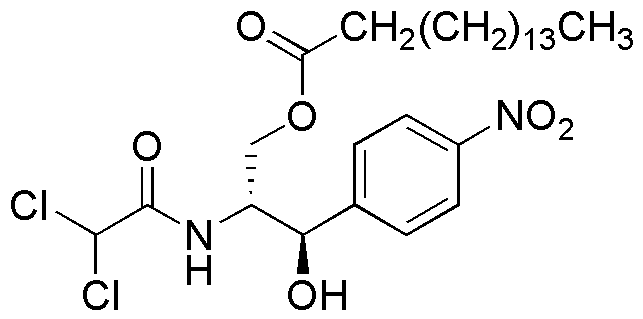Chloramphenicol palmitate is widely utilized in research focused on
- Pharmaceutical Development: This compound is often used in the formulation of oral medications, especially for pediatric patients, due to its palmitate ester form which enhances solubility and absorption.
- Antibiotic Research: It serves as a model compound in studies aimed at understanding antibiotic resistance mechanisms, helping researchers develop more effective treatments.
- Veterinary Medicine: Chloramphenicol palmitate is used in veterinary applications to treat bacterial infections in animals, providing a crucial alternative when other antibiotics are ineffective.
- Drug Delivery Systems: The compound is explored in the development of novel drug delivery systems, allowing for targeted release and improved therapeutic outcomes.
- Analytical Chemistry: It is employed in analytical methods to quantify chloramphenicol levels in biological samples, ensuring safety and compliance in pharmaceutical manufacturing.
Informations générales
Propriétés
Sécurité et réglementation
Applications
Chloramphenicol palmitate is widely utilized in research focused on
- Pharmaceutical Development: This compound is often used in the formulation of oral medications, especially for pediatric patients, due to its palmitate ester form which enhances solubility and absorption.
- Antibiotic Research: It serves as a model compound in studies aimed at understanding antibiotic resistance mechanisms, helping researchers develop more effective treatments.
- Veterinary Medicine: Chloramphenicol palmitate is used in veterinary applications to treat bacterial infections in animals, providing a crucial alternative when other antibiotics are ineffective.
- Drug Delivery Systems: The compound is explored in the development of novel drug delivery systems, allowing for targeted release and improved therapeutic outcomes.
- Analytical Chemistry: It is employed in analytical methods to quantify chloramphenicol levels in biological samples, ensuring safety and compliance in pharmaceutical manufacturing.
Documents
Fiches de données de sécurité (FDS)
La FDS fournit des informations de sécurité complètes sur la manipulation, le stockage et l’élimination du produit.
Spécifications du produit (PS)
Le PS fournit une description complète des propriétés du produit, notamment sa composition chimique, son état physique, sa pureté et les exigences de stockage. Il détaille également les plages de qualité acceptables et les applications prévues du produit.
Certificats d'analyse (COA)
Recherchez des certificats d'analyse (COA) en saisissant le numéro de lot du produit. Les numéros de lot et de lot se trouvent sur l'étiquette d'un produit, après les mots « Lot » ou « Lot de fabrication ».
Numéro de catalogue
Numéro de lot/série
Certificats d'origine (COO)
Ce certificat d'exploitation confirme le pays dans lequel le produit a été fabriqué, et détaille également les matériaux et composants utilisés et s'il est issu de sources naturelles, synthétiques ou autres sources spécifiques. Ce certificat peut être requis pour les douanes, le commerce et la conformité réglementaire.
Numéro de catalogue
Numéro de lot/série
Fiches de données de sécurité (FDS)
La FDS fournit des informations de sécurité complètes sur la manipulation, le stockage et l’élimination du produit.
DownloadSpécifications du produit (PS)
Le PS fournit une description complète des propriétés du produit, notamment sa composition chimique, son état physique, sa pureté et les exigences de stockage. Il détaille également les plages de qualité acceptables et les applications prévues du produit.
DownloadCertificats d'analyse (COA)
Recherchez des certificats d'analyse (COA) en saisissant le numéro de lot du produit. Les numéros de lot et de lot se trouvent sur l'étiquette d'un produit, après les mots « Lot » ou « Lot de fabrication ».
Numéro de catalogue
Numéro de lot/série
Certificats d'origine (COO)
Ce certificat d'exploitation confirme le pays dans lequel le produit a été fabriqué, et détaille également les matériaux et composants utilisés et s'il est issu de sources naturelles, synthétiques ou autres sources spécifiques. Ce certificat peut être requis pour les douanes, le commerce et la conformité réglementaire.


